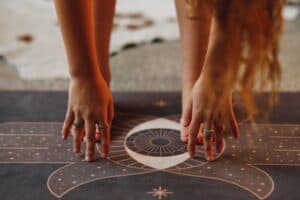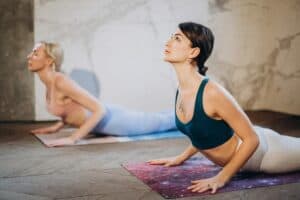Vinyasa yoga is the kind of flow yoga that coordinates your movement and breath into a fluid motion that looks more like a dance than a set of asanas. Vinyasa is the perfect way for beginners to feel strength in their body and experience dynamic meditation through each movement. Discover the fundamentals of vinyasa and how to practice at home with this introductory guide.
What Is Vinyasa Yoga
 Vinyasa is one of the fundamental practices you face at a yoga class. This dynamic practice focuses not only on poses but also on the breathing techniques that accompany the flow.
Vinyasa is one of the fundamental practices you face at a yoga class. This dynamic practice focuses not only on poses but also on the breathing techniques that accompany the flow.
Vinyasa is not a set sequence of poses; you won’t find two practices alike. Vinyasa is a freedom of expression; it’s about what you feel instead of rigid rules.
What Yoga Is Best for Weight Loss?
Historically, it goes back to the early era of yoga practice. The current Vinyasa fundamentals are closely connected to a major figure in the modern image of yoga, Tirumalai Krishnamacharya.
From the linguistic perspective, vinyasa derives from the particles “vi” and “nyasa.” Yogapedia translated the combined meaning as “to place in a special way.”
Overall, the term encompasses several definitions, including
- the transition between poses
- the combination of breath and movement
- the dynamic yet fluid sequence
- yoga classes focused on such flow
Can You Practice Vinyasa at Home?
Like any type of yoga, vinyasa can be practiced at home. There is no need for a whole class to enjoy the benefits and fluidity of Vinyasa flow yoga. Once you learn the basics, feel free to create your own flow depending on what you feel.
I suggest YouTube sequences for the several initial practices. The yogi community has created numerous vinyasa videos for people of all levels. In this way, you can follow a teacher’s instructions and learn the right techniques without the pressure of judgment from others. Do you watch a yoga channel already? The best options for beginners would be Yoga with Adriene (Vinyasa video provided) and Floating Yoga School. Both channels upload beginner-friendly flows that will introduce you to the basic sequences.
What to Know Before Vinyasa Practice?
As you prepare for your first yoga flow, there are a few fundamental rules to keep in mind.
Move With Breath
Each movement in a vinyasa flow is accompanied by breath. The breathe yoga technique used for this practice is called Ujjayi Breath – a rhythmic inhale and exhale through the nose. Focus the mind on matching up each movement with one breath. Your breathing should be slow and even. In the beginning, you may find difficulty synchronizing it with all your movements, even feel lightheaded at times, but practice makes perfect.
Why Yoga Breathing Is Important?
The general rule is to inhale as the body goes up and exhale as you go down.
Your Comfort
During no vinyasa practice should you feel uncomfortable, both mentally and physically.
First and foremost, vinyasa is not about the physical strain and building muscle; these are just side benefits of the practice. Vinyasa is a comfortable practice that is meant to teach you self-love and how to connect our emotions to the body.
Patience
Yes, vinyasa is beginner-friendly, but many of its asanas require strength and flexibility to some degree. However, this fact should not deter you from enjoying the practice, as certain variations can be done to make it more comfortable while you train your body. Video sequences for beginners will come in handy here.
As you build the foundation of strength and flexibility, you’ll be able to take on more advanced classes.
Sun Salutation
 One of the frequently used sequences used for a vinyasa yoga class is Sun Salutation. It is also used by another type of yoga – Ashtanga, which is, according to the majority of yoga practitioners, a slightly different, more rigid and structured type of yoga.
One of the frequently used sequences used for a vinyasa yoga class is Sun Salutation. It is also used by another type of yoga – Ashtanga, which is, according to the majority of yoga practitioners, a slightly different, more rigid and structured type of yoga.
The following Sun Salutation sequence is provided by Yoga Journal and can be used as an example of a short vinyasa practice.
Tadasana
Start with the mountain pose – stand straight with feet slightly apart and arms relaxed, palms facing forward.
Urdhva Hastasana (Inhale)
Raise your arms in wide arcs and overhead. Bring your palms together and direct your gaze towards the fingers.
Uttanasana (Exhale)
Lower your hands back and fold forward. Bend your knees to feel comfortable and lower your torso as much as you can. You can either set your palm on the mat or on a yoga block. Release the tension in your shoulders and neck.
Ardha Uttanasana (Inhale)
Lift your torso up parallel to the floor and keep a straight back.
High Lunge (Exhale)
Step your right foot back into a long lunge. Make sure to keep the left knee over the heel and thigh parallel to the floor. Keep the right thigh and core engaged.
Adho Mukha Svanasana (Inhale)
Transition to a downward-facing dog. Both hands firmly on the floor, step the left foot back and lift your pelvis up.
Plank Pose (Exhale)
Lower your torso parallel to the floor. Make sure your shoulders are directly above the hands. Tuck your pelvis in.
Chaturanga Dandasana (Exhale – continue)
Shift a bit forward, and bend your elbows. As you lower, make sure that your upper arm is parallel to the floor, hands placed near the rib cage.
Urdhva Mukha Svanasana (Inhale)
Straighten arms and transition to an up dog. Switch from the toes to the tops of your feet. Move your chest forward and up, keep your legs engaged, pelvis slightly off the floor.
Adho Mukha Svanasana (Exhale)
Return to the down dog. Pelvis up, back straight, shoulders away from the neck.
To finish the circle, step your right foot into a lunge>Ardha Uttanasana>Uttanasana >Urdhva Hastasana>Tadasana.
You’ll also find that the sequence Chaturanga Dandasana>Urdhva Mukha Svanasana>Adho Mukha Svanasana is also known as vinyasa.
What Are Mudras in Yoga: Ultimate Guide
A proper vinyasa flow practice bears numerous benefits to the body and mind. In the beginning, it stretches the muscles, then opens the joints, and, finally, improves circulation in the organs. Vinyasa yoga trains your mind and body, and greatly decreases stress levels which is critical in the hectic modern world.